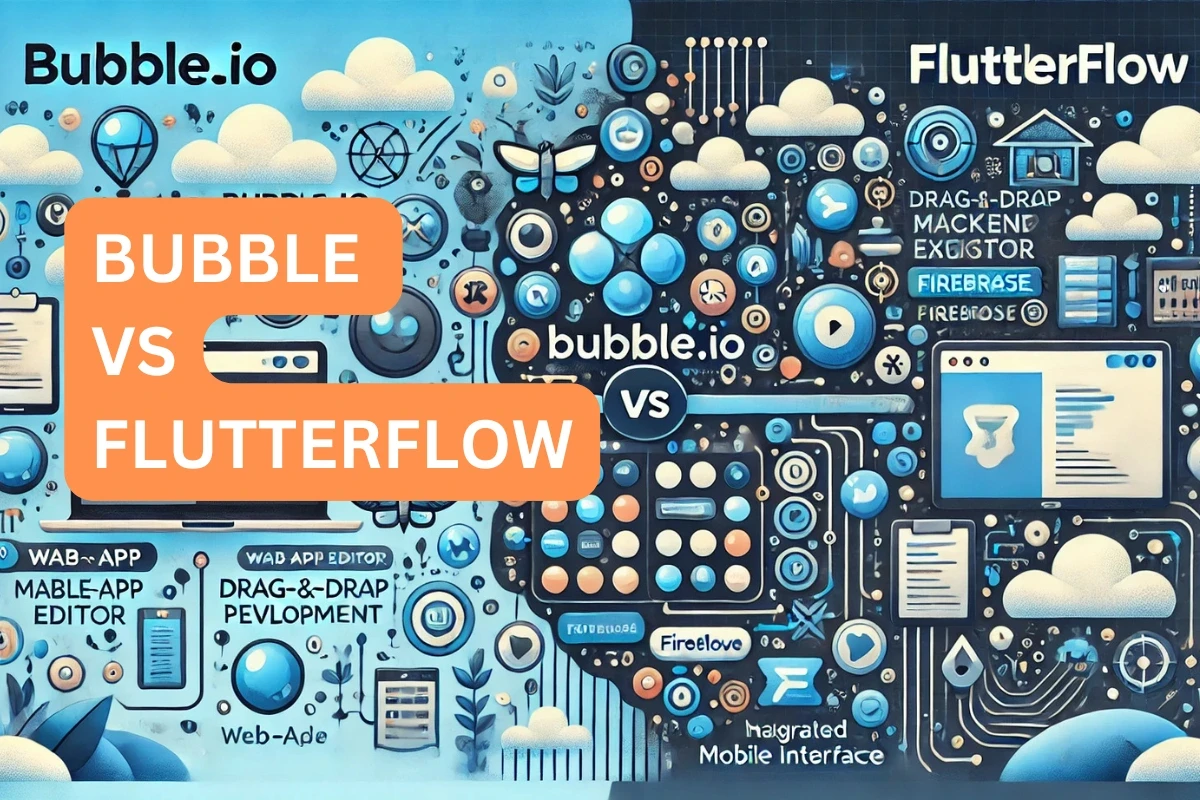
Simon Jenner
Friday 8 November 2024

This post compares Bubble.io and FlutterFlow, two popular no-code platforms catering to different needs. Bubble.io excels in web app development, offering integrated backend services and extensive customization via a visual editor. FlutterFlow focuses on mobile app development, providing code export, high performance, but requires external services for backend functionality.
Posted in:
No-Code
In the growing world of no-code and low-code platforms, Bubble.io and FlutterFlow have emerged as top choices for building applications without extensive coding knowledge. Million Labs has extensive experience in developing in both platforms and therefore this is hopefully an unbiased view.
While both are powerful tools, they have different strengths, catering to distinct needs and preferences. In this blog post, we’ll compare the pros and cons of Bubble.io and FlutterFlow, helping you decide which platform is best suited for your next project.
Bubble.io
Bubble.io is a versatile no-code platform primarily focused on web application development (although their mobile app developer is in beta and will be launched in 2025) . It’s designed for building complex web apps with a drag-and-drop interface, integrated backend, and extensive customisation options.
Pros of Bubble.io
Comprehensive Web App Development:
Bubble.io is ideal for creating sophisticated, feature-rich web applications. It offers a powerful visual editor that allows users to build everything from landing pages to full-fledged web apps.
Integrated Backend:
One of Bubble’s standout features is its built-in backend services. It includes a native database (PostgreSQL), user authentication, and server-side logic, eliminating the need for third-party integrations (saving cost).
Extensive Plugin Ecosystem:
Bubble’s plugin marketplace offers a wide range of third-party integrations, allowing you to extend your app’s functionality with ease.
Advanced Workflow Capabilities:
Bubble allows users to define complex workflows and automate various actions, making it suitable for dynamic applications that require robust logic.
Active Community and Resources:
Bubble has a strong community of developers and no-code enthusiasts. There are plenty of tutorials, forums, and educational resources available, making it easier to get started.
Cons of Bubble.io
Limited to Web Applications (although mobile development is currently in beta):
Bubble is primarily designed for web apps. While you can create responsive designs, it doesn’t natively support mobile app development without using third-party wrappers.
Steeper Learning Curve:
Despite being a no-code tool, Bubble’s vast array of features and customisation options can be overwhelming for beginners.
Performance Issues with Complex Apps:
As your application grows in complexity, performance can become a concern, especially with heavy workflows and large databases.
No Code Export:
Bubble apps are locked within the platform, and there’s no option to export the code. This can be a drawback if you plan to migrate to a different platform in the future.
FlutterFlow
FlutterFlow is a no-code platform built on Flutter, Google’s open-source UI toolkit for building native apps. It focuses on mobile app development, providing a user-friendly interface to design and deploy native apps for iOS and Android.
Pros of FlutterFlow
Native Mobile App Development:
FlutterFlow specialises in creating native mobile apps, making it a great choice for developers looking to build high-performance iOS and Android applications.
Code Export Capability:
One of FlutterFlow’s biggest advantages is the ability to export Flutter code. This allows developers to extend their projects with custom code or migrate the app to a full development environment if needed.
Firebase Integration:
FlutterFlow integrates seamlessly with Firebase, providing real-time data storage, authentication, and cloud functions. This makes it easy to build data-driven mobile apps.
Pre-built Widgets and Templates:
The platform offers a variety of pre-built widgets, templates, and animations, speeding up the design process and enabling users to create visually appealing interfaces quickly.
Cross-platform Support:
With FlutterFlow, you can build apps that run on both iOS and Android from a single codebase, reducing development time and effort.
Cons of FlutterFlow
Limited Web App Support:
Although FlutterFlow apps can be adapted for web, its primary focus is on mobile development. The web experience may not be as polished as its mobile counterparts.
External Backend Required:
Unlike Bubble, FlutterFlow does not have an integrated backend. You’ll need to use external services like Firebase, Xano or Supabase for data storage and server-side logic (adding at least $50 per month to the cost). Having to manage and develop on two different platforms i.e. Flutterflow & Xano means slower development.
Smaller Ecosystem:
While growing rapidly, FlutterFlow’s ecosystem is still smaller than Bubble’s, with fewer third-party plugins and integrations available.
Less Customisation in No-Code Mode:
FlutterFlow’s no-code interface may limit advanced customisations compared to working directly with Flutter code, which might be a drawback for more experienced developers.
Comparison

Which Platform Should You Choose?
Choosing between Bubble.io and FlutterFlow depends largely on the type of application you want to build and your project requirements:
Choose Bubble.io if you need to build a complex web application (mobile or desktop) with robust backend services and extensive customisation. It’s ideal for creating dynamic websites, SaaS products, marketplaces or internal business tools without writing code.
Choose FlutterFlow if you’re focused on creating native mobile apps for iOS and Android, with the flexibility to export code and integrate with Firebase. It’s perfect for startups, MVPs, and developers who want a streamlined way to build mobile apps.
Top resources to Start, Launch and Grow your SaaS:
Building Your No-Code MVP: A Complete Guide to Launch Within the Next 60 Days
Mastering App Scoping: The Only Guide You'll Need as A First Time Founder
Ready to launch your startup idea with an MVP?
Download our step by step guide for non-technical founders to create a startup Minimum Viable Product (MVP)
Get the eBook

